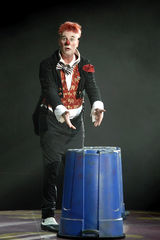Difference between revisions of "Main Page"
From Circopedia
| Line 35: | Line 35: | ||
[[File:Dougherty_2008.jpg|right|160px]] | [[File:Dougherty_2008.jpg|right|160px]] | ||
| − | === | + | ===CIRCUS SARRASANI=== |
| − | + | The legendary Circus Sarrasani was created in Germany in 1901 by a visionary clown and animal trainer, Hans Stosch (1873-1934). Sarrasani remains one of the most celebrated circus names in both Europe and South America. The title was alive throughout the entire twentieth century, under a succession of owners of more or less legitimate lineage. In circus lore, Sarrasani is still a fabled name that evokes a history of epic proportions with sociopolitical undertones, dominated (and occasionally brought close to bankruptcy) by the larger-than-life personality and extravagant vision of its famous founder, Hans Stosch-Sarrasani. | |
| − | + | Hans Stosch's vision, which came to full fruition in the late 1920's during the Republic of Weimar, shaped his circus as a paradigm of modernity and exoticism, which went far beyond the traditional approach of the major traveling circus families of the period. Stosch had a matchless ability to mix together industry, stagecraft, propaganda, literature, foreign politics, a specific style of circus management and circus aesthetics—as well as innovative techniques that stand today as milestones in the history of modern circus. His achievements influenced rivals such as [[Carl Krone]], colleagues and admirers such as Jérôme Medrano and John Ringling North, and even, four generations later, Bernhard Paul.... ([[Circus Sarrasani|more...]]) | |
==New Biographies== | ==New Biographies== | ||
Revision as of 22:31, 31 August 2014
|
In The Spotlight
CIRCUS SARRASANI
The legendary Circus Sarrasani was created in Germany in 1901 by a visionary clown and animal trainer, Hans Stosch (1873-1934). Sarrasani remains one of the most celebrated circus names in both Europe and South America. The title was alive throughout the entire twentieth century, under a succession of owners of more or less legitimate lineage. In circus lore, Sarrasani is still a fabled name that evokes a history of epic proportions with sociopolitical undertones, dominated (and occasionally brought close to bankruptcy) by the larger-than-life personality and extravagant vision of its famous founder, Hans Stosch-Sarrasani.
Hans Stosch's vision, which came to full fruition in the late 1920's during the Republic of Weimar, shaped his circus as a paradigm of modernity and exoticism, which went far beyond the traditional approach of the major traveling circus families of the period. Stosch had a matchless ability to mix together industry, stagecraft, propaganda, literature, foreign politics, a specific style of circus management and circus aesthetics—as well as innovative techniques that stand today as milestones in the history of modern circus. His achievements influenced rivals such as Carl Krone, colleagues and admirers such as Jérôme Medrano and John Ringling North, and even, four generations later, Bernhard Paul.... (more...)
New Biographies
- Pancracio, Clown
- Circus Sarrasani, History
- Tom Dougherty, Clown
- Alfred Beautour, Cat Trainer
- Ali Hassani, Acrobat and Circus Owner
New Videos
- Claudius Specht, juggler (2013)
- Diana Aleschenko & Yury Chavro, Unicycle Adagio (1995)
- The Rastellis, Clowns (1976)
- Philippe Gruss, Leopard Act (1965)
- Tom Dougherty & Pepe Silva, Clowns (2012)
Featured Oral Histories
- Nikolai Pavlenko, tiger trainer - Interview (RIA Novosti, 2012)
- Alberto Zoppé, Equestrian - Interview (McCutcheon & Distasio, 2003)
- Olivier Taquin, Mime - Interview (Jando, 2008)
- Barry Lubin, Clown (Grandma) - Interview (Jando, 2008)
- Fumagalli, Clown - Interview (Jando, 2008)
A Message from the Editor
CIRCOPEDIA is a constantly evolving and expanding encyclopedia of the international circus. New videos, biographies, essays, and documents are added to the site on a weekly—and sometimes daily—basis. So keep visiting us: even if today you don't find what you're looking for, it may well be here tomorrow! And if you are a serious circus scholar and spot a factual or historical inaccuracy, do not hesitate to contact us: we will definitely consider your remarks and suggestions.
- Dominique Jando
- Editor/Curator
